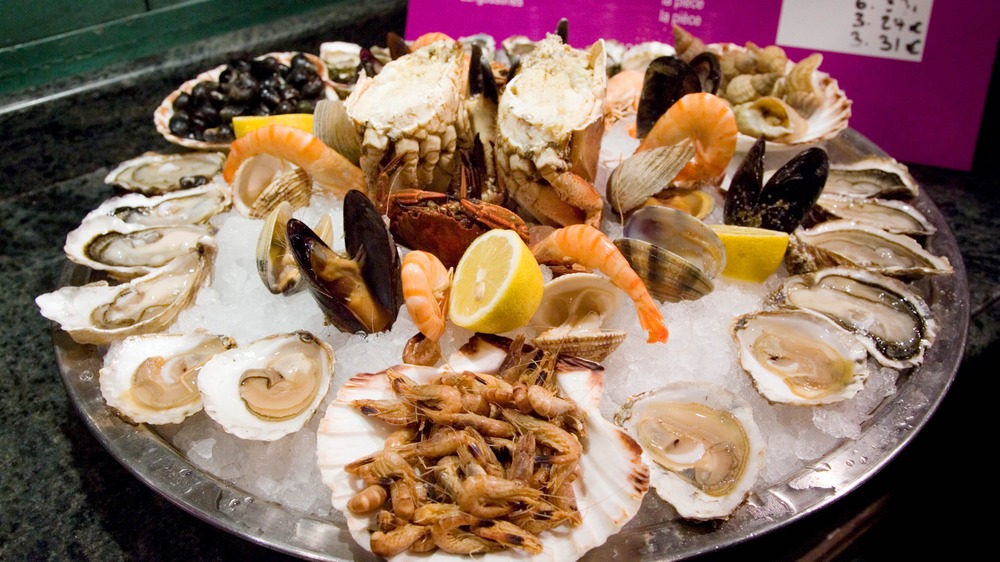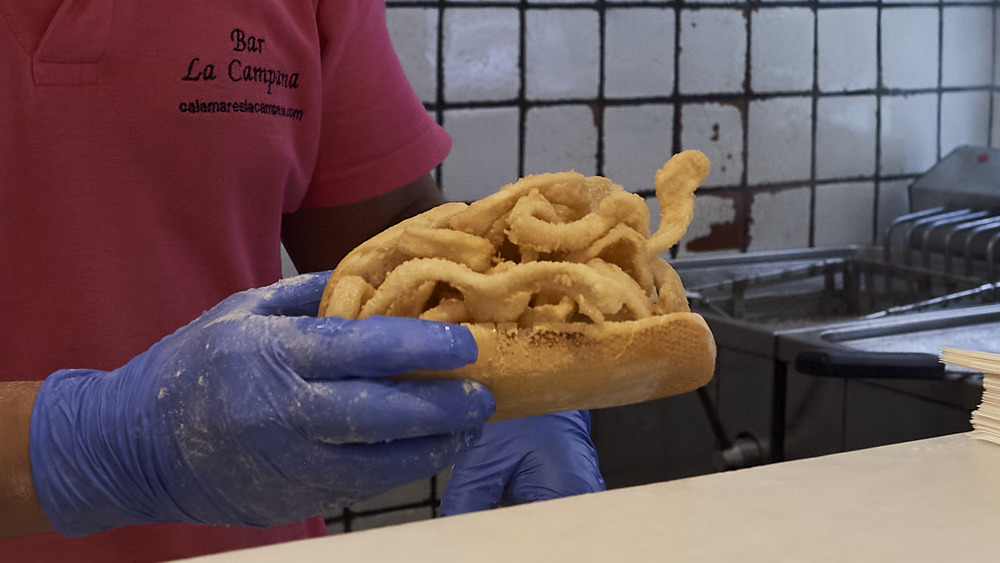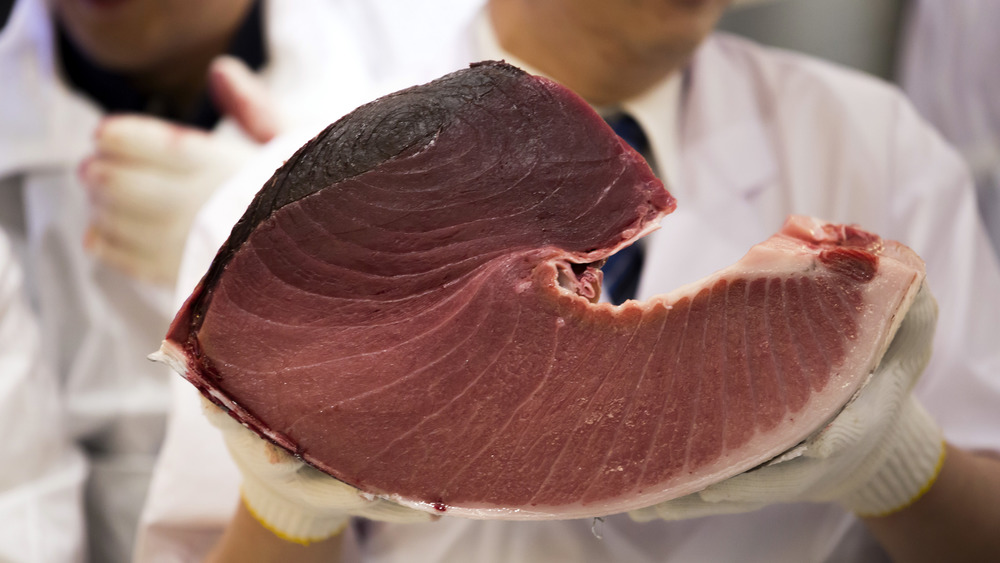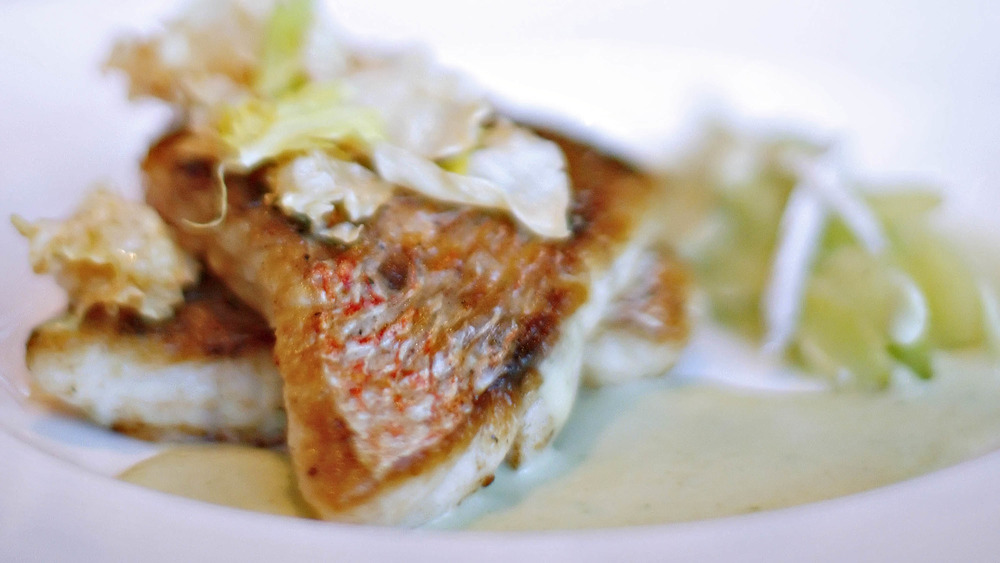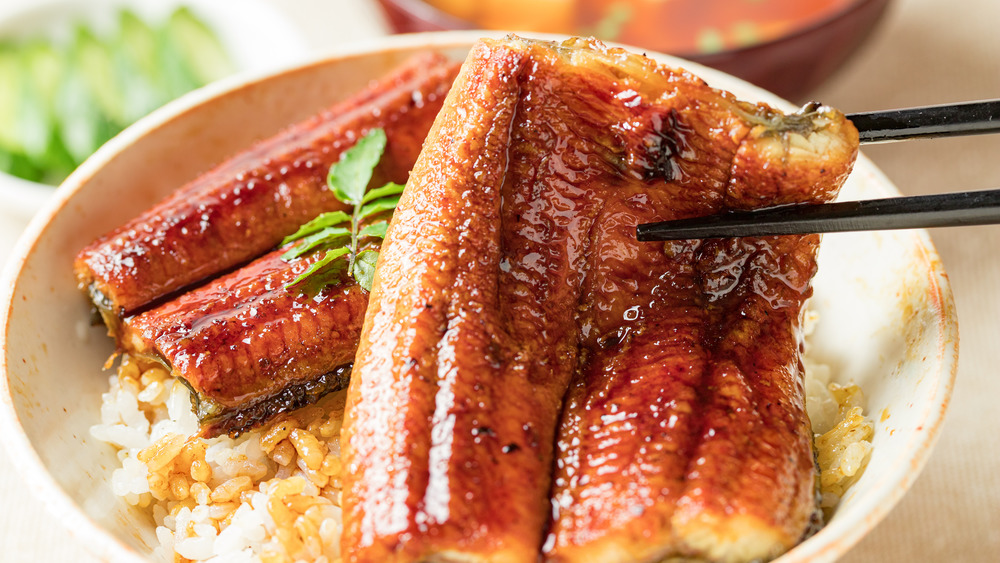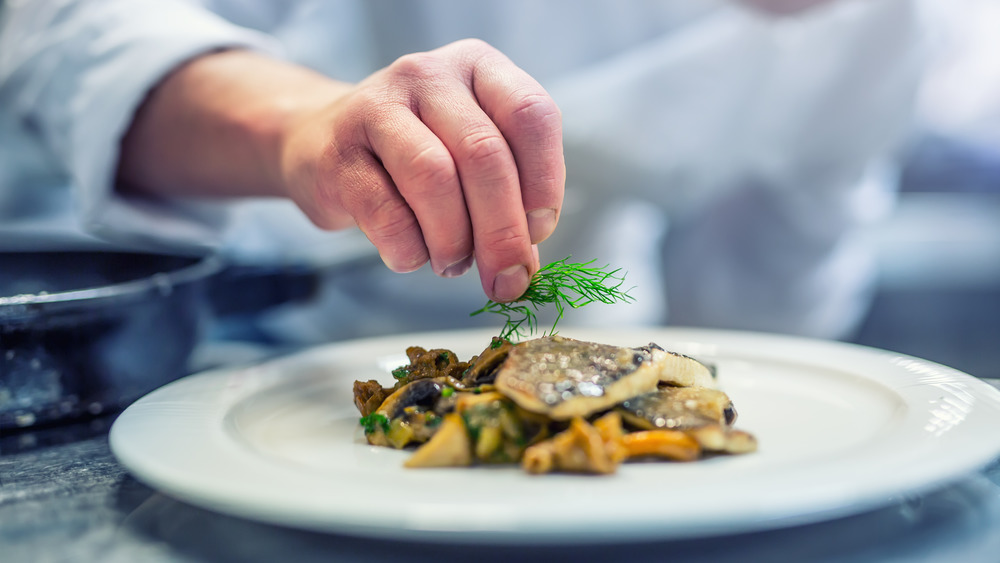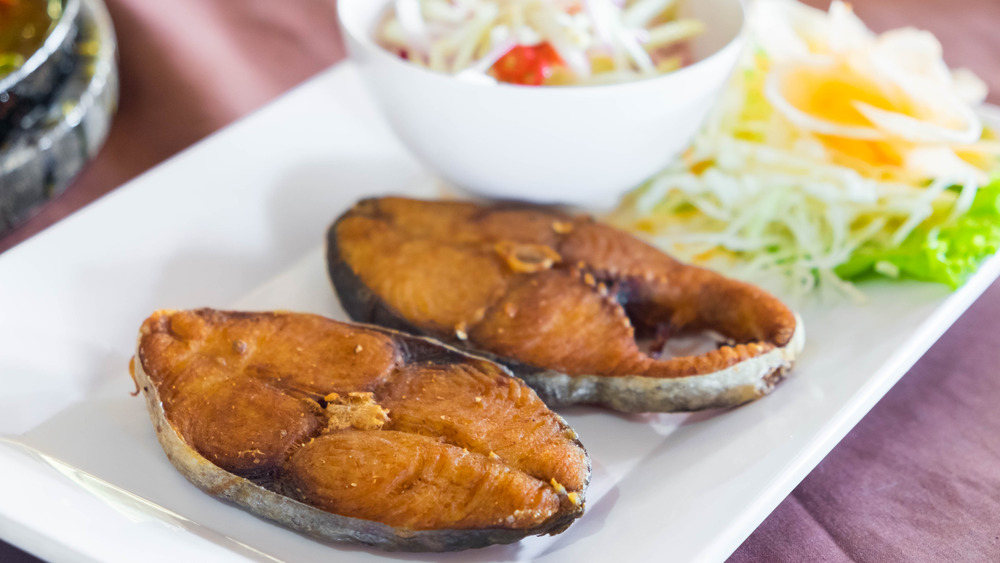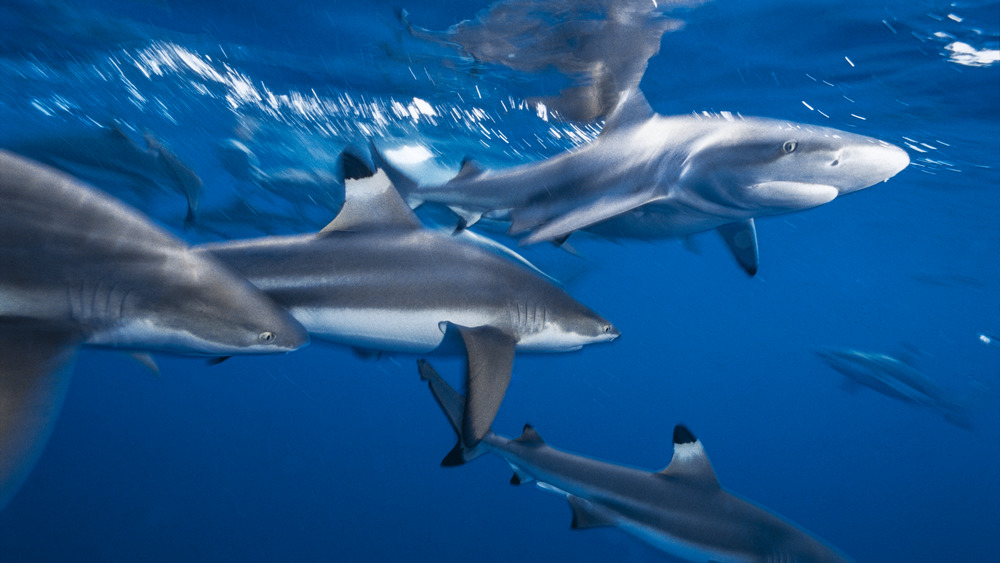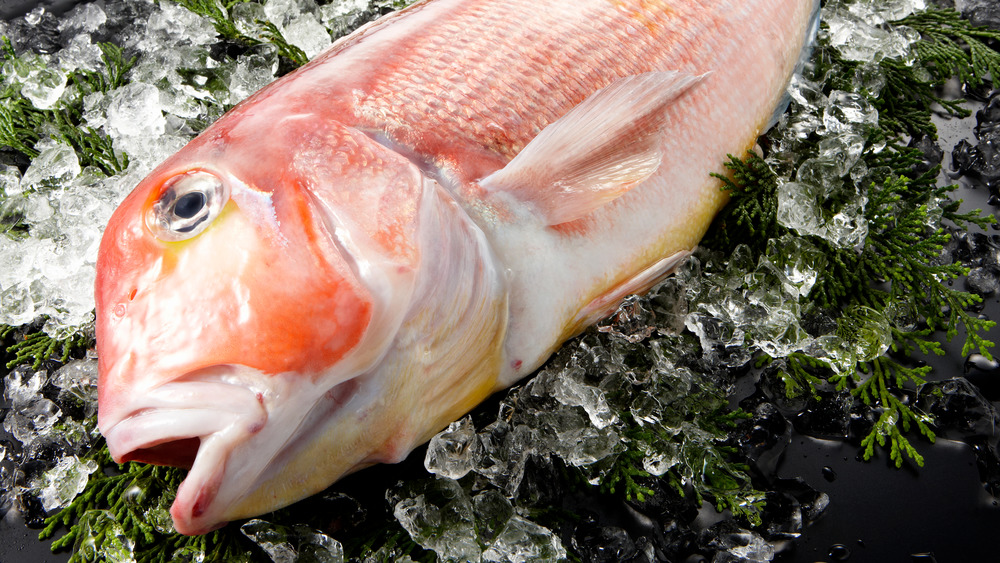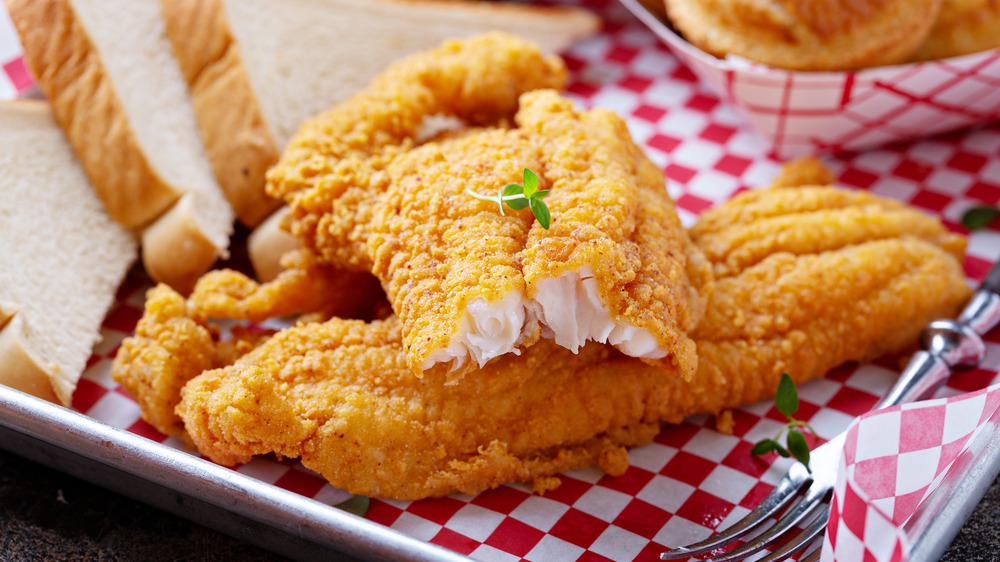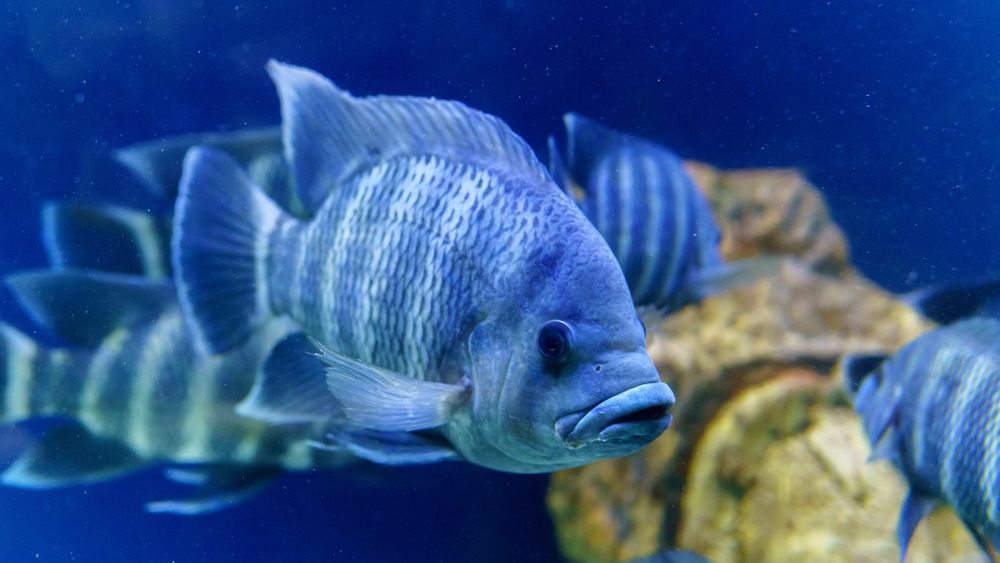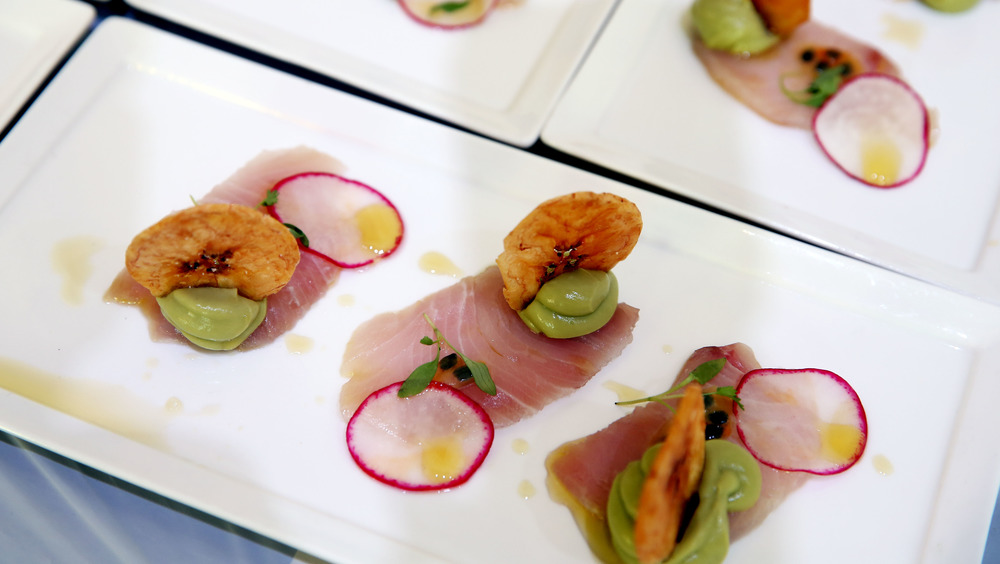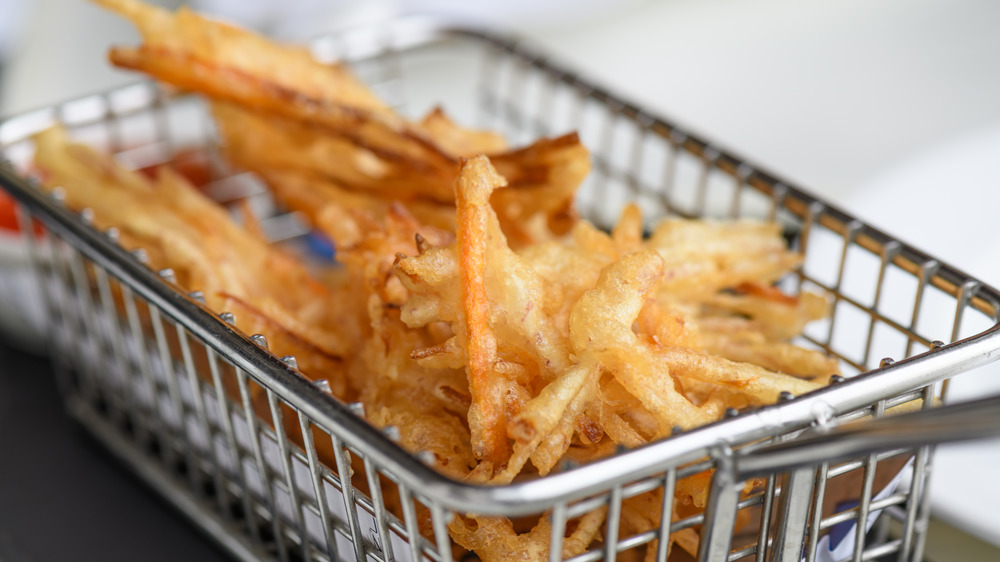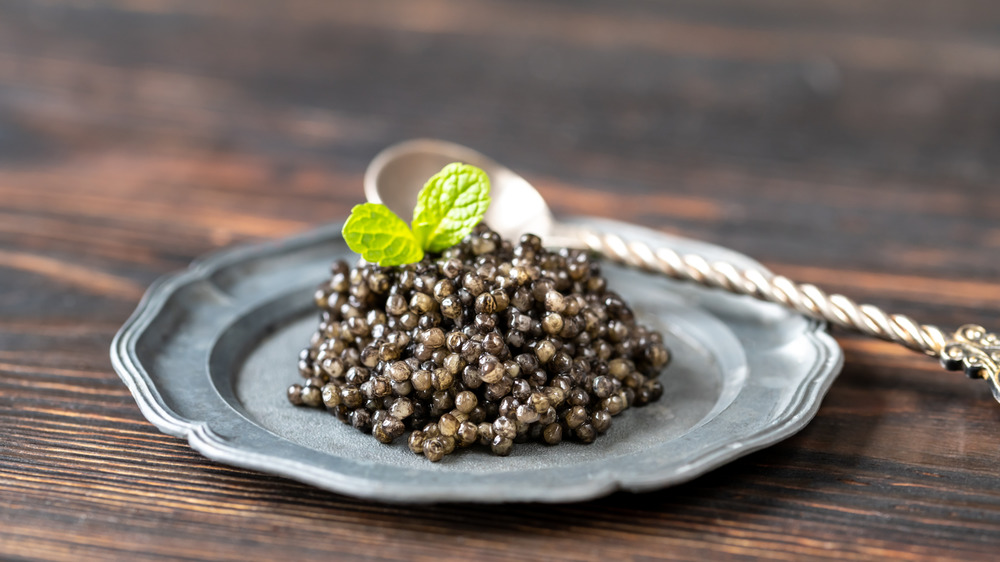13 Things You Should Never Order From A Seafood Restaurant
Whether it's Red Lobster or your favorite local seafood shack, or even a high-end, fine-dining restaurant, when it comes to ordering seafood out, there's a little bit of risk involved. Sure, you could order seafood out for years and never have an issue, but talk to most seafood connoisseurs and you'll soon realize that many have at least one horror story under their belt — the far-from-fresh scallops that ruined their weekend, the sushi that was most definitely not the type of fish it was advertised as.
Additionally, many diners assume seafood is healthy across the board. After all, we're constantly told how healthy fish is — low-fat, filled with Omega-3 fatty acids, part of a heart-healthy diet, better than red meat. But that doesn't mean that unhealthy items aren't lurking on your favorite seafood restaurant's menu. And on top of all this, consuming seafood is tied to many negative environmental factors. For instance, overfishing endangers important fish populations, while poor fishing practices result in pollution and waste in our oceans. So, with all this said, how are you supposed to even enjoy eating seafood? Well, it all comes down to what you order.
Being careful with what you order at a seafood restaurant can go a long way in ensuring you're only eating healthful, relatively risk-free options, as well as seafood options that aren't potentially endangering the planet. That being said, here are the 13 things you should never order from a seafood restaurant.
Fried calamari is the top seafood restaurant starter to stay away from
Is there any seafood appetizer as popular as fried calamari? Even restaurants that aren't particularly known for their seafood dishes serve up this favorited appetizer. However, just because fried calamari is seafood, that doesn't make it necessarily healthy also. In fact, fried calamari is one of the unhealthiest things you can order at many seafood restaurants, and that goes for across the entire menu, not just the appetizer selection.
Just take a look at the crispy calamari and vegetables on Red Lobster's menu. This appetizer packs a whopping 1,830 calories, with 1,140 calories from fat (reflecting 127 grams of total fat); and 4,720 milligrams of sodium. That means, if you're an average adult with a mostly sedentary lifestyle and you order this appetizer, you've eaten either mostly all of your calories for the day or more than your calories for the day, according to Food and Drug Administration (FDA) recommendations. It also means that you've greatly exceeded the recommended amount of sodium intake in one day, as the American Heart Association recommends definitely no more than 2,300 milligrams of sodium per day and ideally no more than 1,500 milligrams of sodium per day for most adults.
Bluefin tuna is one of the most popular tunas used in sushi restaurants — and it's endangered
If you have a particular love for sushi, you may enjoy the occasional tuna roll, but you'll want to watch out for bluefin tuna, which sometimes goes by other names, including maguro, akami, toro, otoro, and chutoro. Bluefin tuna, according to the World Wildlife Fund, is one of the largest types of tuna, and there are three different species of bluefin tuna, the most endangered species being Atlantic bluefin tuna. Despite the name, Atlantic bluefin tuna aren't actually sourced from the Atlantic Ocean; instead, most of them come from the Mediterranean.
Both in the United States and abroad, Atlantic bluefin tuna is a top choice for sushi and sashimi and, as a result, bluefin tuna is overfished. Why exactly is this a big deal? Well, bluefin tuna rank pretty high up on the marine food chain, so when they're gone, it impacts a huge swathe of other marine life below them.
And why can't the bluefin tuna fishing just be managed properly to prevent overfishing? As the World Wildlife Fund points out, a lot of the bluefin tuna fishing is done illegally, allowing fishers to get around regulations. You can do your part to help address this issue by asking your restaurant what type of tuna they're using. Yellowfin tuna and bigeye tuna are more sustainable options.
That snapper at your favorite seafood restaurant isn't what you think it is
Love ordering snapper at your local seafood restaurant? You may not actually love snapper; instead, you could be falling for another fish. That's because, according to one Eater article, snapper is one of the most common "fake" foods on restaurant menus. An Oceana study found that snapper was the most incorrectly labeled type of seafood, with a mislabeling rate of 87%. Tuna took the second place, at 59%. According to the study and its samples, "Only seven of the 120 samples of red snapper purchased nationwide were actually red snapper. The other 113 samples were another fish."
So what actually is the snapper on your plate? Oceana said that, oftentimes, tilapia is passed off as snapper, because tilapia is usually farmed, making it more affordable. However, the organization also noted that, if you are going to order snapper, the best place to do so would be Florida. The study found Florida to be the geographic area with the least amount of mislabeling, probably because the waters off the coasts of Florida are filled with readily-available snapper, making it easier and more affordable to source.
Eating endangered eels at seafood restaurants is a multi-faceted issue, especially for the Japanese
Eel, sometimes referred to as unagi when served grilled, basted, and in sushi, is a popular treat both in Japan and in certain U.S. restaurants. Unfortunately, eels are endangered across the world and overfishing puts them at great risk, but despite the concerns, there's still that huge unagi demand.
According to The Houston Press, in Japan, freshwater eel populations declined 90% over the last three generations. In Maine, where a lot of eel fishing takes place, baby eel theft is on the rise, with baby eels going for as much as $1,500 apiece; this is partially because eels can't feasibly be bred in captivity, so they're all wild-caught. This is no new problem, though. It was nearly 10 years ago when the Japanese government first added the freshwater eel to its endangered species list, calling the multi-layered issue, "an environmental crisis for the endangered species and its habitat, a financial crisis for the centuries-old unagi industry, and a cultural crisis for the Japanese public."
For now, American restaurant-goers are urged to stop ordering endangered eels, if only to help alleviate the growing issue. And if the declining eel populations isn't enough to convince you, maybe consider that eel is extremely toxic if not properly cooked, even in minuscule amounts.
Whatever the special at a seafood restaurant is, you don't want it
Every foodie has heard Anthony Bourdain's likely most well-known advice: Never order the fish on a Monday, because it's probably just leftover from the weekend. That advice pertains to seafood specials, too.
We can all agree that fresh fish is the best fish, and restaurant specials can be a way for a chef to move a certain ingredient. As Chef Siliva Barban noted in an Insider article, "Specials are tricky in restaurants. It could be the most fresh and delicious special, but in some restaurants, specials are the way to clean up the fridge." Sure, specials can go both ways, but when it comes to fish — an ingredient that relies on freshness for its quality, not to mention its safety (which could mean a chef is even more tempted to push it harder, to get it out the door) — wouldn't you want to err on the side of caution? To play it safe, whenever you're at a seafood restaurant, especially on a Monday, just avoid the special and go for your favorite, regular menu item.
That king mackerel restaurant dish is likely high in mercury
Fish and shellfish come with some risk of high mercury, but for the most part, it's not necessarily a worry. According to Harvard Health Publishing, most men don't need to worry about mercury exposure from seafood. Unfortunately, that's not the case for pregnant women, breastfeeding women, or children. That's because, as the FDA says, while mercury occurs naturally in the environment, it's also released into the air via industrial pollution and that mercury can accumulate, fall to the ground, and then infiltrate local water sources, the ocean, and rivers.
The mercury is then absorbed by the fish, which you then absorb when you eat the fish, and this pollution-caused mercury is the type that can harm women and children. However, mercury becomes more concentrated in certain types of fish, and king mackerel is right at the top of the list, alongside shark, swordfish, and tilefish, the FDA reports.
Looking for fish low in mercury? Go for shrimp, salmon, pollock, or canned light tuna.
Do your part to save the sharks the next time you visit a seafood restaurant
Speaking of sharks, though, the high mercury content isn't the only reason why you want to avoid eating this delicacy at seafood restaurants. While shark meat is legal to eat in the United States, it's still highly frowned upon by those who know a bit about the industry's behind-the-scenes practices and the popularity of "finning." A Food&Wine article on the topic explains that "finning involves catching sharks, removing their fins, and then cruelly releasing the sharks back into the water alive."
Fishers find this method attractive primarily because the fins are the most in-demand part of the shark and, by only taking the fin and dumping the helpless shark (which, at that point, can't swim and lies helpless until they're either eaten by another marine animal or they suffocate) overboard, they can save room in their boats for more fins. Currently, finning, as well as buying and selling shark fins, is illegal in 11 states. Where eating shark fins is legal, the fins are eaten a range of ways, from cold to cooked, canned to frozen. You probably won't find shark fins for sale in the United States, but if you do see shark on the menu at a seafood restaurant, it's likely served as a steak or fillet.
Ordering the tilefish at a seafood restaurant could lead to expansive problems for other species
Tilefish has become a relatively popular seafood option, but it's one to steer clear of, for more reasons than its high mercury content. Tilefish, which are caught along the Atlantic Coast of North America, all the way from Nova Scotia and down to the Gulf of Mexico, are usually caught via longlines, and they are, according to the Environmental Defense Fund, "highly susceptible to overfishing" and management plans have been put in place to help tilefish populations rebound.
Even with these management plans, though, there's still an issue with the way tilefish are caught. The longlines, the National Audubon Society explains, cause a multitude of problems for other species. Longline fishing kills what's known as "bycatch," or marine animals unintentionally killed by a fishing operation; longline bycatch includes blue marlin, turtles, bluefin tuna, and sharks. Unfortunately, fixing this issue isn't an easy one, and one of the simplest ways to cut down on longline fishing damage is to simply reduce demand; in other words, don't order the tilefish.
Take a closer look at that catfish before ordering at the local seafood joint
Try to tell any southerner that catfish is bad and you'll likely find yourself in a fight. Fried or blackened catfish is a common staple on many a southern menu, seafood restaurant or otherwise. However, before you chow down on this favorited and affordable food, it's worth digging into where and how that catfish was raised.
Compared to coastal fish farming, catfish farming is relatively environmentally-friendly, as well as safer for both the fish and for the end consumer. However, if the catfish on your plate wasn't raised in the United States, that might not be the case at all. According to Prevention, if your catfish was imported to the U.S., there's a good chance it came from Vietnam, where catfish farmers frequently use antibiotics on the fish that are outlawed in the United States. Additionally, two fish that the Vietnamese call "catfish" aren't actually considered catfish in the United States — meaning the treatment is even more difficult to monitor.
So, if you really want catfish, ask if the catfish on the menu was raised or caught locally, or at least stateside.
When ordering seafood, consider that tilapia are tough — a little too tough
Most tilapia is farm-raised, which comes with a few downsides. Depending on the fish farm, the tilapia will be fed grain-rich diets filled with GMO foods, including corn and soybeans. Additionally, there's a chance that farmed tilapia could contain toxins, depending on where it's raised.
If the tilapia is raised overseas and imported, things get worse: As the Washington Post reports, Chinese-imported tilapia are sometimes fed diets of poultry and livestock waste (still, the Monterey Bay Aquarium Seafood Watch only cautions diners to avoid tilapia imported from one specific country, and that's Colombia).
Beyond all this, though, tilapia is a tough, hardy fish, which makes them dangerous to their ecosystems. Farmed tilapia are known to escape (yes, really) and, once they're out, they wreak havoc on local fish populations. Escaped "feral" tilapia over-compete with other fish for resources (and win) and can significantly alter habitats via eating water plants and even building nests.
To avoid all of the above, maybe skip the tilapia the next time you dine out?
The white tuna at a restaurant is likely something much more dangerous
A lot of fish go by a multitude of names, which means it can be difficult to ensure you're only eating what you actually want to eat. While "white tuna" and "albacore" are often used interchangeably to describe the same fish, if you see anything referred to as "super white tuna," it's escolar (which also sometimes goes by "shiro maguro"), and escolar can cause a huge range of issues.
Known for causing gastrointestinal distress, escolar is admittedly yummy, sustainable, affordable, and healthy — other than that gastrointestinal thing, of course. Escolar has a particularly high oil content, and the oil found in escolar is similar to castor oil. And just like consuming castor oil will cause you some discomfort, so will consuming escolar. The reported discomfort is pretty extreme, too, and is often difficult to control, sudden, surprising, and, well, explosive. In fact, escolar is sometimes referred to as "the ex-lax fish" and it's even banned in Japan and Italy. If you purchase escolar in Canada, Sweden, or Denmark, you'll see that it comes with a warning label.
We all can likely agree that gastrointestinal distress is something to avoid, so, for your pants' sake, avoid the escolar or the trickily named "super white tuna" and "shiro maguro."
There's a reason the Japanese warn against eating tempura under conditions common at seafood restaurants
As a deep-fried, fatty food, tempura isn't going to be the healthiest option on any seafood restaurant menu, but there's another reason why you might want to avoid it the next time you dine out. Culturally, the Japanese warn against eating tempura under very specific, but seemingly harmless, conditions.
A journalist for The Japan Times wrote about a nasty experience following enjoying some tempura and watermelon: "I'd indulged in a classic bad food combination, or tabeawase. Called gasshokukin or shokugokin, these are foods that are not supposed to be eaten with each other for health reasons, especially during the summer when the grueling heat and humidity take a toll on our bodies." In other words, pairing deep-fried, oily tempura with anything cold and watery, from watermelon to other fruit (though watermelon is the most commonly warned-against tempura pairing), is a recipe for digestive disaster.
So, if you're watching your waistline, skip the tempura. If you're worried about tummy troubles, though, just watch what you're eating alongside your tempura.
Next time you order seafood at a restaurant, help save one of the world's oldest fish species: the Atlantic sturgeon
The Atlantic sturgeon is one of the oldest fish species, but it's facing extinction due to a range of issues, from overfishing to watershed development, says the Yale School of the Environment. A fish with an abundant backstory, the Atlantic sturgeon was used primarily for its caviar for decades, and the species is to thank for Delaware becoming the caviar capital of North America in the 1800s. In fact, when fishers flocked to Delaware to harvest the caviar, it was called the "black gold rush."
Now, Atlantic sturgeon are considered endangered or threatened, depending on the population segment. The best way to help solve the issue? Pass on Atlantic sturgeon and, when offered caviar, ask where it's from. It's not uncommon for caviar to be sourced under rather ... fishy ... circumstances (like this 2021 instance of Wisconsin's notorious "sturgeon general" and his caviar scheme) and avoiding caviar sourced from Atlantic sturgeons can help the population rebound to previous centuries' numbers.
